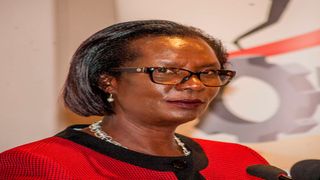
Ms Lyn Mengich Chairperson of the Salaries and Remuneration Commission during a press briefing on the third remuneration and benefits review cycle for state and public officers for the period 2023/2024 and 2024/2025 on August 9, 2023, at Fairmont Norfolk Hotel, Nairobi.
| Billy Ogada | Nation Media GroupBusiness
Premium
Windfall for teachers, uniformed forces and civil servants in salary review
What you need to know:
- The teaching service has been allocated Sh9.6 billion (44.2 per cent), uniformed and disciplined forces Sh4.5 billion and county governments Sh4 billion.
Ms Mengich said the salary reviews, to be effected in the current and next financial years, focused on pulling the low earners towards the ideal salary range.
The average salary increase for the employees will be between 7 per cent and 10 per cent, inclusive of an annual 3 per cent increase that has been in place.
Teachers, police officers and disciplined forces, and workers in county governments are the biggest beneficiaries in the latest pay review by the Salaries and Remuneration Commission (SRC) as they get increments that are higher than those of other public servants.
Of the Sh21.66 billion allocated for salary reviews in the current financial year, 83.9 per cent (Sh18.2 billion) has been channelled to the three categories of workers.
The teaching service has been allocated Sh9.6 billion (44.2 per cent), uniformed and disciplined forces Sh4.5 billion and county governments Sh4 billion.
SRC on Wednesday (August 9, 2023) indicated that the review—meant to harmonise salaries across the public service to achieve equity and fairness—adjusted salaries in favour of the lowest earners in national and county governments, while partially freezing salary increments for the highest earners, mostly in State corporations and secretariat staff in commissions and independent offices.
“This review is about harmonisation of pay, we are trying to get a sense of equity and fairness in pay. It’s not so much about additional pay and that is why there is no much increase for State corporations,” said SRC Chairperson Lyn Mengich.
Ms Mengich added that after commissioning labour market salary surveys to find out how different public agencies pay their workers compared to their comparable private sector counterparts, the commission realised huge disparities, with some agencies paying huge salaries as workers in others earn peanuts.
The SRC used a model that ranked jobs according to their current gross remuneration, settling on the middle of salaries paid to comparable private sector counterparts as the ideal, and terming such salaries the 50th percentile.
According to the model, the teaching service is ranked lowest in the 36th percentile, followed by civil servants in national and county governments in the 39th percentile. Some state corporations rank highest in the 89th percentile, followed by secretariat staff in commissions and independent offices in the 84th percentile.
Low earners
Ms Mengich said the salary reviews, to be effected in the current and next financial years, focused on pulling the low earners towards the ideal salary range.
“Due to historical reasons, the public service has disparities in remuneration and benefit structures. The different market positions ranging from the 36th percentile to the 89th percentile are a demonstration of the disparities that we have in the remuneration structures and therefore this review seeks to adjust salaries that are below the 50th percentile so as to achieve equity and fairness,” Ms Mengich said.
The average salary increase for the employees will be between 7 per cent and 10 per cent, inclusive of an annual 3 per cent increase that has been in place.
The pay increase will be backdated to July 1, meaning that workers in public service are currently owed the July additional dues.
On the other hand, workers in corporations who are currently enjoy huge salaries will only be entitled to the annual 3 per cent increment.
“Although the pay structures are frozen, there is still an increase that is given as part of the notch increases that happen. A freeze in a structure doesn’t mean that there will be no pay rise in State corporations. There will be exceptions for State corporations that are also way below the 50th percentile. Those will be looked at on a case by case basis,” Ms Mengich said.
The commission noted interesting cases where it had found low-cadre officers in State corporations earning salaries even beyond the President’s, highlighting the inequality.
“To address the overlap between the pay of public and State officers, we decided to address equity across all and not just select officers. A number of officers in State corporations may earn higher than the Cabinet secretary and even the President,” said the SRC chairperson.
The proposed raise in salaries is part of the commission’s implementation of the 2021/22–2024/25 remuneration and benefits review cycle. On advice from Treasury, the commission had frozen salary increments in the first two years of the cycle—2021/22 and 2022/23—due to the Covid-19 pandemic.
But SRC and Treasury said the economy had rebounded since last year and there were projections of continued positive performance.
Treasury CS Njuguna Ndung’u noted that the Sh21.66 billion allocation fell far short of the requests by SRC, but Treasury allocated the amount based on economic performance. The commission had indicated that Sh340 billion is needed to fully harmonise remuneration and benefits across the public service.
Economic recovery
“The National Treasury appreciates the fact that this is not what SRC would have required but they have considered the slow economic recovery and the economic structure, they have looked at the structural inequality of growth and they have listened to the National Treasury,” Prof Ndung’u said.
The CS also said the model used in the distribution of the additional salaries was based on consideration of government workers who have suffered the most from prevailing economic hardships.
“We are budgeting that for this year and a similar amount for next year because we are conscious that we have to come down to the realities that public sector workers are struggling because of shocks that have hit the economy,” the CS said.
The salary increases are expected to push teachers from the 36th percentile to the 39th, and civil servants in national and county governments from the 39th percentile to the 42nd.
“The intention is to grow those that are below to catch up with those that are high. That is the thrust of this third remuneration review cycle. We are largely looking at how to progressively harmonise those that are at the lowest level, the TSC and the PSC, towards a better position,” said SRC Vice-Chair Amani Komora.
The commission announced the increase after communicating to public agencies in the national and county governments to abolish and/or review some four allowances that it considers double compensation.
The allowances include retreat, which is recommended for abolition, taskforce, which is recommended for review and abolition in some instances, and daily subsistence and sitting allowances for internal institutional committee members, recommended for review.





